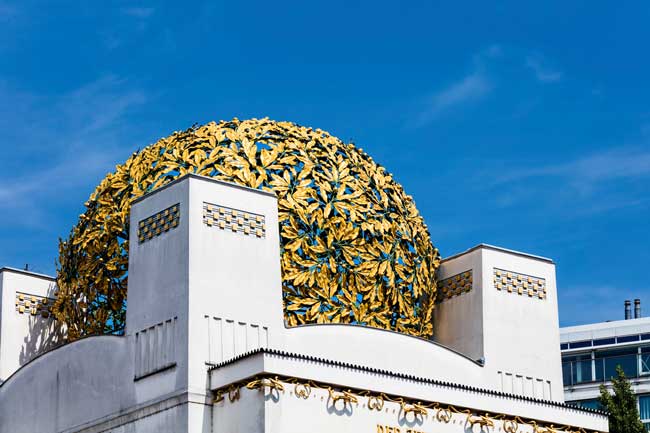

Visitors to Vienna are frequently stunned by the city’s architectural and artistic grandeur. They shouldn’t be. What today is the capital of a relatively small country was once the center of power for the Austro-Hungarian Empire, the second largest country in Europe after the Russian Empire and the third most populous.
Its rulers, the powerful Habsburg dynasty, over the centuries shaped Vienna as a magnificent expression of their influence and prestige. The famous “Ring,” the system of wide boulevards where the medieval city’s walls once stood, even today is lined with glittering, elegant structures, including just one of the Hapsburg’s palace complexes and others housing government and cultural institutions.
Arts in Vienna
In addition to Vienna’s political importance, it’s also been a hotbed of creative ferment. As the city where Mozart, Beethoven, Schubert, and Strauss lived and worked, Vienna’s musical heritage is especially strong, but so were its influences in the visual arts, literature, architecture, and even fashion. Intellectuals like Sigmund Freud also made Vienna their home, making it a center where ideas that reshaped the world emanated from.
That all came crashing down in 1918. With the end of the first World War, Austria-Hungary found itself at the mercy of the victorious Allies and was broken up into several smaller nations, none as politically powerful as the empire preceding them.
Vienna’s cultural influence also began to wane that year since, by the sheerest of coincidences, 1918 was the year marking the deaths of four of the city’s artistic icons — the painters Gustav Klimt and Egon Schiele, architect and city planner Otto Wagner, and graphic designer and decorative artist Koloman Moser.
This year, a century after this defining moment in its history, Vienna is choosing to celebrate its artistic achievements with a year-long, city-wide remembrance of the work of these four cultural titans. Using “Beauty and the Abyss” as its catchphrase and theme, the city is encouraging tourism to places where the work of these artistic giants can best be seen, well as throwing a number of special events and exhibits highlighting their work. Here are some “best bets” where you can do just that.
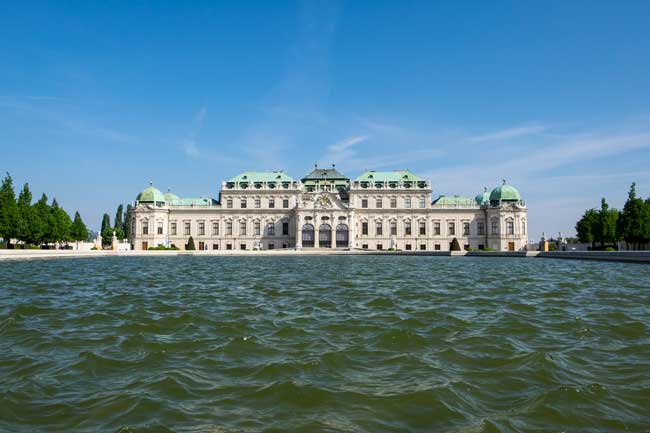
The Belvedere Palace Museum
The Belvedere Palace is one of Vienna’s principal jewels, a Baroque masterpiece — actually two of them — an Upper Palace at the summit of a small hill, with the Lower Palace below, connected by a sloping formal garden with manicured shrubbery, fountains, and dozens of statues.
Built as a summer residence for Prince Eugene of Savoy in the early 18th century, the Belvedere was once outside the city proper but nowadays is in the center of Vienna’s thriving cultural scene. In fact, the Belvedere plays a major part in that scene because it’s now a museum showcasing Austrian art from medieval times to the present.
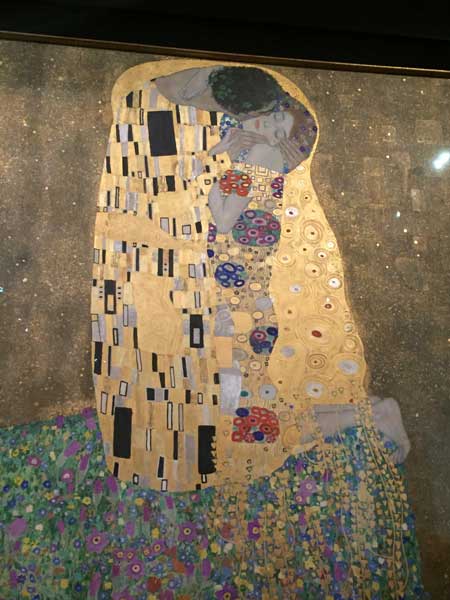
One of the major draws of the Belvedere for art lovers is that it has the largest collection in the world of Gustav Klimt’s paintings — 24 of them. Many are examples of Klimt’s “Jugendstil” style of painting, the Viennese form of Art Nouveau.
Perhaps the most popular is “The Kiss,” showing a couple embracing in a meadow of flowers — It’s believed to be a portrait of Klimt himself with his lover, Emilie Flöge.
Nearly six feet square, “The Kiss” is a highlight of Klimt’s “Golden Period” where the artist developed a technique of combining gold leaf, oils, and bronze paint. Its mosaic effect is believed to have been inspired by Byzantine motifs Klimt saw in Italy. Also, in this gallery you’ll find your eyes drawn to Klimt’s Biblically themed “Judith,” a portrait of a lavishly dressed, voluptuous woman incongruously holding the head of Holofernes.
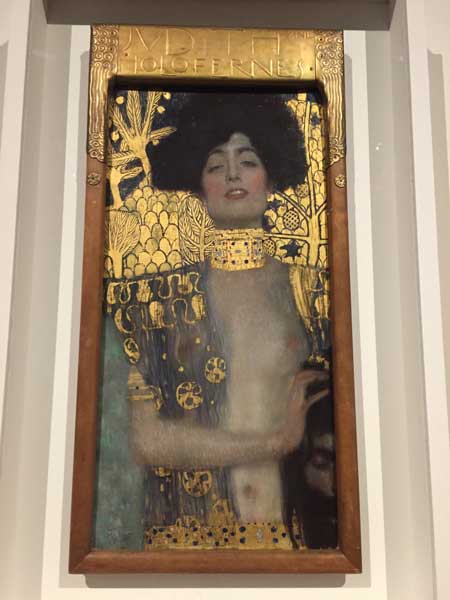
In fact, most of the Belvedere’s collection of Klimt paintings can be found in this same gallery where “The Kiss” and “Judith” are located. You’ll be lucky to find yourself alone or with just a few people surrounding you, since the immense popularity of Klimt’s work is one of the major draws to the museum.
The gallery is frequently thronged with people, sometimes including entire tour groups. Consider arriving in the morning when the Belvedere first opens.
The Klimt paintings, and in fact the entirety of the Belvedere’s permanent collection, are in the Upper Palace, where the ornate rooms have huge windows offering magnificent views of the city. In other galleries, you’ll find Impressionist paintings, Classical masterpieces like a giant portrait of Napoleon on horseback, and a few works by Egon Schiele, who, like Klimt, died in 1918.
The Lower Palace, with interiors as sumptuous as its counterpart, is the site for temporary exhibits such as the current “Beyond Klimt: New Horizons in Central Europe,” where the works of 80 artists demonstrate that the vitality of the cultural community continued after 1918.
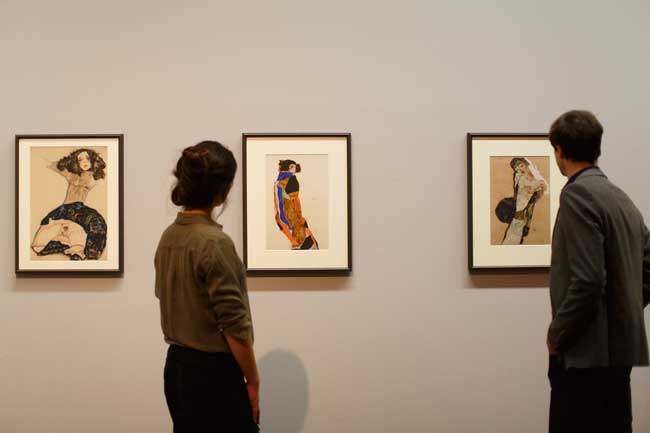
The Leopold Museum
Named by the London Times in 2013 as one of the 50 most important art galleries in the world, the Leopold is just one part of the massive Museumsquartier, a sprawling complex of buildings housing theaters, festival halls, dance studios, and museums for art, architecture and children. The varied cluster of buildings ranges from the baroque former imperial stables to the futuristically designed Leopold.
Austrian artwork of the 20th century is the Leopold’s focus. Its collection of the work of Egon Schiele, a protegé of Klimt’s who tragically succumbed to the Spanish flu epidemic in 1918 at the age of 28, is especially strong. In fact, it’s the largest collection of Schiele’s work in the world.
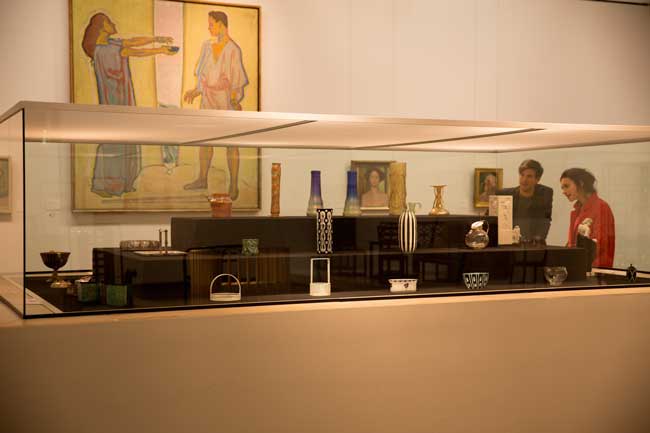
Because the museum owns 40 of Schiele’s paintings and 180 of his works on paper, several galleries are devoted solely to his work. As a result, there’s no better place anywhere to experience its impact, which is both haunting and powerful.
Shiele broke with the prevailing Art Nouveau style to be an early precursor to Expressionism with its explosive colors, twisted body shapes, and expressive lines, all with an emphasis on eroticism and sexuality — Schiele seemed to revel in stark exhibitionism, and his work frequently includes dualities — both beauty and horror, life and death, the ecstatic and the demonic.
Make what you will of Schiele’s work, but you’ll probably not be able to pull your eyes away from it. It’s both disturbing and sublimely beautiful at the same time. Among the most famous of his pieces owned by the Leopold are “Portrait of Wally” and “Self-Portrait with Physalis.”
Elsewhere in the Leopold, you’ll see some of Klimt’s landscapes, his famous painting “Death and Life,” and a reproduction of his studio. There’s also a room devoted to works of the Wiener Werkstätte, Austria’s form of the Arts and Crafts movement, with its focus on the decorative arts.
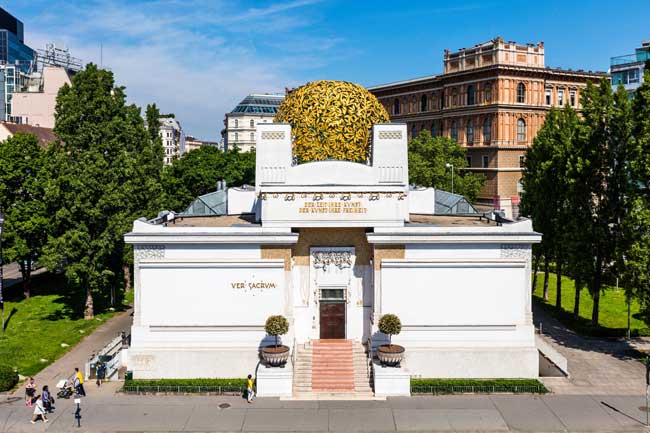
The Secession Building and Its Neighborhood
A hallmark of Vienna is its striking architecture, but few structures grab your attention more forcefully than the Secession building with its huge dome of 3,000 gold-plated iron leaves that’s been freshly regilded for this anniversary year. Built in 1897 to house the Secession, a collective of artists rebelling against the established art community, the amazing edifice is one of the key works of Viennese Art Nouveau.
The Secession Building still houses artwork, mostly in temporary exhibitions, but the main reason to go inside is Gustav Klimt’s astounding Beethoven Frieze, a 112-foot-long and 7-feet-high mural meant as an allegorical interpretation of Beethoven’s Ninth Symphony. Klimt let his imagination run wild.
There are floating genies, choirs of angels, naked couples embracing, and a giant unforgettable monster with shaggy fur, blue wings, a snake-like body, and piercing eyes made of mother-of-pearl.
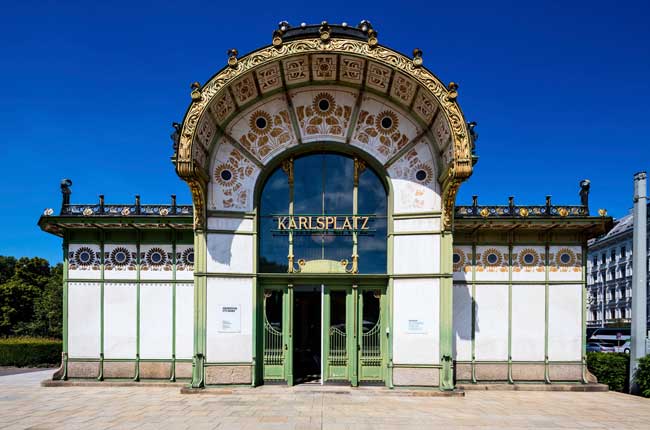
The neighborhood surrounding the Secession Building is a good springboard to explore the work of the architectural giant, Otto Wagner, the “elder statesman” of the four artists who died in 1918. Born in 1841, Wagner was one of the influential architects who did the most to reshape the appearance of the Austrian capital during his lifetime.
One of his key projects was construction of the stations and bridges of the former Stadtbahn railway line, now absorbed into the city’s subway systems. Close to the Secession Building, a pair of especially fine station buildings can be found at nearby Karlsplatz, particularly elegant with their marble slabs and gilded ornamentation. One station has a museum devoted to Wagner’s work that’s open during the summer months. The other has a café.
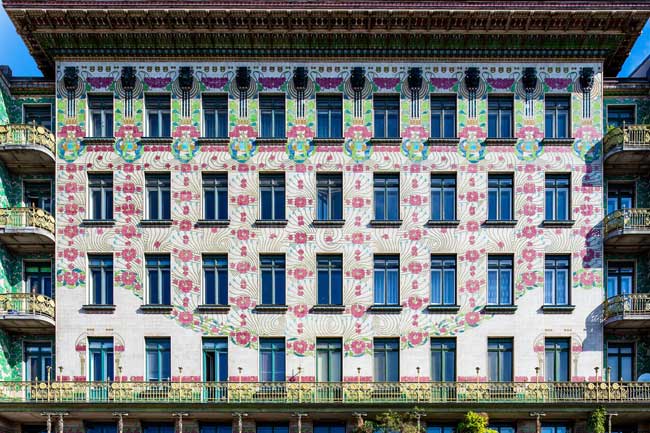
Also nearby, on the street called Linke Wienziele, are a trio of sizable apartment buildings that were designed by Wagner. One, called the Majolikahaus, is clad with floral tiles, while another has impressive ornamentation on the exterior by Koloman Moser, the decorative artist who also died in 1918. The third building is the plainest, but is the one where Wagner himself resided for a time in an apartment reputedly with a glass bathtub that’s since disappeared.
While you’re in this neighborhood, you’d be remiss not to make a stop at the huge Naschmarkt, an outdoor market with food stands, restaurants, craft vendors, and periodic flea markets. It’s just adjacent to Wagner’s apartment buildings. Close to the train stations on Karlsplatz is the breathtaking Karlskirche (St. Charles Church), a soaring Baroque Rococo structure. Be sure to take the elevator to the top of the frescoed dome for views of the city’s skyline and the lavishly ornamented interior.
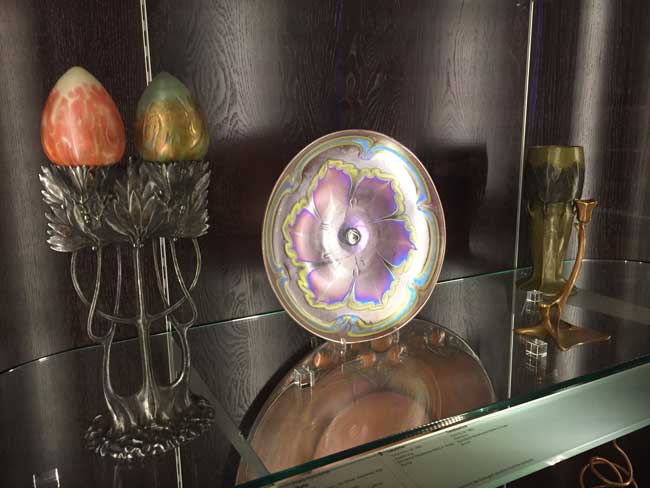
The MAK and Nearby
To experience yet another of Vienna’s artistic heritages, go to the MAK, the Museum für Angewandte Kunst, or the Museum of Applied Arts. It’s an amazing compendium of the decorative arts, including furniture, porcelain, glass, ceramics, and jewelry. There are rooms of eye-catching posters, a gallery of “floating” carpets, and a long line of Bentwood rockers and chairs, their shadows artfully reflected against a cloth backdrop. In the basement, themed displays can be seen on objects associated with “Eating and Drinking” or “Sitting.”
But to see items associated with the period of Viennese Modernism, the artistic movement that “Beauty and the Abyss” is celebrating, go to the second floor to an area called “Vienna 1900.”
It’s a stunning hodgepodge of vases, dishware, fabrics, tables and chairs, stemware and cutlery, all reflecting the aesthetic of what’s called the “Wiener Werkstätte,” a production community of visual artists devoted to raising everyday objects into art forms. Even the tea and coffee service sets on display here are gorgeous.
This is the best place in Vienna to see the work of the fourth artist who died in 1918, Koloman Moser, a designer who worked in several art forms. Objects he designed on display in this part of the MAK include a buffet cabinet, a secretary desk, and glassware table set.
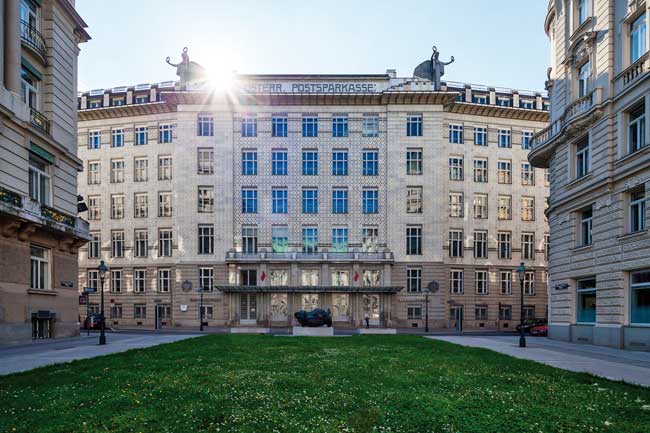
Just a short walk from the MAK is another stunning building designed by Otto Wagner, the Austrian Postal Savings Bank, built between 1904 and 1906. Here Wagner’s architecture takes a decidedly futuristic bent.
The facade is covered in weatherproof granite and aluminum — In fact, it’s believed that 1/6 of the world’s aluminum production during that period was used in this building’s construction. The building has been purchased by a private developer and will be re-purposed, but at least through September of 2018 you’re welcome to enter and marvel at the cavernous main hall with its soaring ceilings.
If You Visit Vienna
Each of these museums and many others have a variety of temporary exhibitions opening and closing throughout 2018 to celebrate the works of these four artists. There are also a variety of special tours focused on the subject of Viennese Modernism, and a number of tour guides can be booked for specialized walking tours.
All this information can be conveniently found at two websites. The site www.vienna.info gives an overview of all the city’s main destinations and events, as well as offering the opportunity to book hotels online. Shopping, dining, and entertainment possibilities are also included.
A specialized website, https://viennesemodernism2018.info/en, has a vast panoply of information about the four artists who died in 1918, as well as specifics about where in Vienna their works can be seen.
Author Bio: Ohio-based travel writer Rich Warren travels the U.S. and the world looking for offbeat and off-the-beaten-path stories. He is a graduate of the Elf School of Reykjavik and can tell you what the Amish wear to the beach in Florida.
- 6 Reasons to Visit Portland, Maine (+ Travel Tips) - April 18, 2024
- Cruising with Discovery Princess on the Mexican Riviera - March 30, 2024
- La Paz, Mexico: Pearl on the Sea of Cortez - February 26, 2024
